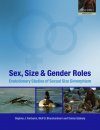![Sex, Size and Gender Roles Sex, Size and Gender Roles]()
Click to have a closer look
About this book
Contents
Customer reviews
Related titles
About this book
Investigates the genetic, developmental, and physiological basis of sexual size dimorphism found within and among the major taxonomic groups of animals. Carefully edited by a team of world-renowned specialists in the field to ensure a coherence of style and approach between chapters, it presents a compendium of studies into the evolution, adaptive significance, and developmental basis of gender differences in body size and morphology.
Adaptive hypotheses allude to gender-specific reproductive roles and associated differences in trophic ecologies, life history strategies, and sexual selection. This "adaptationist" approach is balanced by more mechanistic studies of the genetic, developmental and physiological basis of sexual size dimorphism to provide a comprehensive and authoritative overview of the subject. Throughout the volume the emphasis is on sexual dimorphism in overall size; however, the scope of enquiry encompasses gender differences in body shape, the size and structure of secondary sexual characteristics, patterns of growth (ontogeny), and patterns of gene regulation.
This advanced, research level text is suitable for graduate level students and researchers in the fields of evolutionary biology, behavioural ecology, physiology, developmental biology, and genetics. It will also be of relevance and use to non-biologists from fields such as anthropology and gender studies.
Contents
1. Introduction: The Enigma of Sexual Size Dimorphism; SECTION 1: MACRO-PATTERNS: EXPLAINING BROAD-SCALE PATTERNS OF VARIATION IN SEXUAL SIZE DIMORPHISM; 2. Sexual Size Dimorphism in Mammals; 3. Sexual Size Dimorphism in Birds; 4. The Evolution of Sexual Size Dimorphism in Reptiles; 5. Sexual Size Dimorphism in Amphibians: an overview; 6. Rensch's Rule in Insects: patterns among and within species; 7. Sexual Size Dimorphism in Spiders: patterns and processes; SECTION 2: MICRO-PATTERNS: CASE STUDIES OF PATTERNS AND EVOLUTIONARY PROCESSES WITHIN AND AMONG SPECIES; 8. Variation in Selection, Phenotypic Plasticity and the Ecology of Sexual Size dimorphism in Two Seed-Feeding Beetles; 9. Sexual Dimorphism in Water Striders: a case study of adaptation in response to sexually antagonistic selection; 10. Case Studies of the Differential Equilibrium Hypothesis of Sexual Size Dimorphism in Dung Fly Species; 11. The Genetic Integration of Sexually Dimorphic Traits in the Dioecious Plant, Silene latifolia; 12. Dimorphism in the Hartebeest; 13. Sexual Size Dimorphism and Offspring Vulnerability in Birds; 14. Variation in Sexual Size Dimorphism within a Widespread Lizard Species; 15. Phylogenetic Analysis of Sexual Dimorphism in Eye-Lid Geckos (Eublepharidae): the effects of male combat, courtship behaviour, egg size and body size; SECTION 3: PROXIMATE DEVELOPMENTAL AND GENETIC MECHANISMS; 16. Sex Differences: genetic, physiological, and ecological mechanisms; 17. The Genetic Architecture of Sexual Dimorphism: the potential roles of genomic imprinting and condition dependence; 18. Irreconcilable Differences: when sexual dimorphism fails to resolve sexual conflict; 19. Development of Sexual Size Dimorphism in Lizards: testosterone as a bipotential growth regulator; 20. Sexual Differences in Insect Development Time in Relation to Sexual Size Dimorphism
Customer Reviews



































